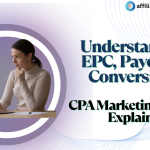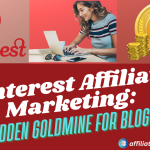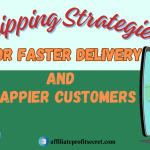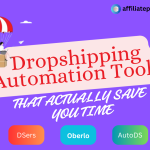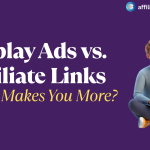Welcome to my article on “Pinterest Affiliate Marketing: A Hidden Goldmine for Bloggers.”. When you think of affiliate marketing, your mind probably jumps to flashy Instagram influencers or YouTubers hawking protein powder in between prank videos. But there’s another platform quietly stacking commissions in the background—one pin at a time. Yep, we’re talking about Pinterest. The place you went to plan your dream wedding (that hasn’t happened yet) or find a banana bread recipe during the lockdown is also a serious money-making machine for savvy bloggers.
In this post, we’ll uncover why Pinterest is an affiliate marketer’s secret weapon—and how you can tap into this hidden goldmine without needing a million followers, a DSLR camera, or a degree in graphic design. Whether you’re a food blogger, fashion lover, finance nerd, or DIY queen, Pinterest has room for your content (and your affiliate links). So grab your virtual pinboard and let’s turn your side hustle into a stream of commissions—one scroll-stopping pin at a time.
My Best Recommended & Proven Way to Make $100-$300 Daily – Watch This FREE Video to START >>>

Why Pinterest Is Perfect for Affiliate Marketing (Especially for Bloggers)
If Instagram is a nightclub and Twitter is a chaotic group chat, Pinterest is your chill, coffee-fueled friend who’s actually productive. It’s where people go to plan, shop, and dream—which, for bloggers and affiliate marketers, is basically a giant, glittery invitation to help those users find exactly what they’re looking for (and get paid in the process).
Here’s the magic: Pinterest isn’t a social media platform in the traditional sense. It’s a visual search engine, which means people aren’t scrolling aimlessly—they’re actively searching for things to buy, try, or learn. That’s buyer intent, and it’s gold for affiliate marketing. Instead of convincing someone to want something, you’re showing up right when they’re already looking for it. No cold pitching. Just perfect timing.
Even better, Pinterest content has insanely long shelf life. A pin you post today could still be bringing in clicks and affiliate commissions six months (or even two years) from now. Try getting that kind of ROI from a 24-hour Instagram Story.
And if you’re a blogger? Even better. Pinterest loves blog-style content—tutorials, how-tos, product roundups, recipes, gift guides, you name it. If your blog post solves a problem or delivers inspiration, it’s practically made for Pinterest. Just add eye-catching pin graphics and sprinkle in some well-placed affiliate links (the ethical kind), and boom—you’re in business.
So while everyone else is busy trying to go viral on TikTok, you can quietly build a Pinterest-powered affiliate engine in the background—no dancing required.
Setting Up a Pinterest Business Account That Converts
Before you start pinning like a pro, there’s one small but mighty step you can’t skip: setting up a Pinterest business account. If you’re still using your personal account to pin cake recipes, DIY hacks, and affiliate products all in one messy digital drawer… we need to talk.
A Pinterest business account isn’t just a fancy title—it unlocks the tools you actually need to grow and monetize. We’re talking analytics, rich pins, and the ability to run ads (even if you’re not planning to just yet). It’s like switching from a flip phone to a smartphone—suddenly, everything just works better.
My Best Recommended & Proven Way to Make $100-$300 Daily – Watch This FREE Video to START >>>
Here’s your quick setup checklist (no tech degree required):
- Create or switch to a business account – Head over to Pinterest settings and either create a new business account or convert your personal one. Don’t worry, your beloved recipe board can still live on.
- Claim your website – This links your blog to your profile, which boosts trust and unlocks analytics on what people pin from your site. It also makes your pins look more official (aka click-worthy).
- Enable Rich Pins – These magical pins pull metadata (like blog titles or product prices) directly from your site. More info = more clicks = more commission potential.
- Optimize your profile – Use a clear, friendly headshot or brand logo, write a keyword-rich bio (think: “Helping women save money & find products they love”), and include a clickable blog link.
And finally—curate your boards like a pro. No, you don’t need 50 of them. Just focus on quality, niche-relevant boards with clear titles (and bonus points for SEO-friendly descriptions). Think of your profile as a mini storefront—it should tell visitors exactly what you’re about, in five seconds or less.
Because in Pinterest land, first impressions aren’t just everything—they’re monetizable.
How to Create Click-Worthy Pins That Drive Affiliate Sales
Let’s be honest—on Pinterest, it’s not enough to just exist. You’ve got to pop. With millions of pins floating around like glitter in a craft store explosion, your pins need to stand out, spark curiosity, and most importantly… get clicked. Because no click = no commission = sad affiliate marketer.
So what makes a pin click-worthy? It’s part art, part science, and part understanding how people scroll with a cup of coffee in one hand and a vague urge to redecorate their entire house in the other.
Here’s the breakdown:
🎨 1. Design Like a Marketer, Not Just a Designer
You don’t need to be Picasso. Tools like Canva make it easy to create stunning pins in minutes. Focus on:
- Bold, readable fonts (especially on mobile)
- Vertical format (2:3 ratio) – Pinterest loves tall pins
- High-contrast colors to grab attention
- Clean layout with room to breathe
- Consistent branding (use your blog colors & fonts!)
And yes—images matter. Use high-quality photos that reflect the mood or result of your affiliate product (i.e., no blurry screenshots or awkward stock models unless they actually help).
✍️ 2. Craft Scroll-Stopping Headlines
Your pin text is your mini sales pitch. Make it snappy, clear, and curiosity-piquing:
- “10 Must-Have Tools for Busy Moms (That Actually Work)”
- “How I Made $500 in One Weekend with One Affiliate Link”
- “This $20 Amazon Find Changed My Morning Routine”
Ask yourself: Would you click this pin at 11pm while procrastinating on laundry?
🧠 3. Use Keywords (Without Sounding Like a Robot)
Pinterest is a search engine. That means your pin titles, descriptions, and even the alt text on your image file should include relevant keywords. But keep it human. Nobody searches for “Top-tier ergonomic lumbar-supported hydration vessel.” Just say “best water bottles for posture.”
📌 4. Link to Value
Don’t send people to a barren product page unless it’s absolutely amazing. Instead, link to helpful blog posts, tutorials, or product roundups that warm the reader up first. It builds trust—and boosts conversions.
In short: your pins need to look good, sound compelling, and offer real value. Pretty pins might get saved, but click-worthy pins get commissions.
Smart Ways to Use Affiliate Links Without Getting Banned
Now, before you go on a pinning spree and turn your Pinterest profile into a digital billboard, let’s pause and talk about the not-so-sexy (but super important) part of affiliate marketing: playing by the rules. Yes, Pinterest allows affiliate links—but only if you don’t abuse the privilege like an unsupervised toddler in a candy store.
My Best Recommended & Proven Way to Make $100-$300 Daily – Watch This FREE Video to START >>>
Getting banned is not just embarrassing—it’s like throwing your income off a cliff. So let’s keep your account squeaky clean and profitable with these smart strategies:
✅ 1. Disclose Like a Grown-Up (Because It’s the Law)
No, #ad isn’t optional. If you’re sharing affiliate links—whether directly on a pin or through a blog post—you must disclose that relationship. Add “#ad” or “This post contains affiliate links” right in your pin description or post.
Think of it as the polite “Just so you know” before the sale. It builds trust, keeps you legal, and Pinterest appreciates the honesty.
🔗 2. Mix It Up: Don’t Pin Like a Bot
Pinterest loves fresh, relevant content. What it doesn’t love? A feed full of nothing but repetitive product pins pointing to the same affiliate link.
Instead:
- Alternate direct affiliate pins with content-rich blog post pins
- Create multiple designs for the same product (fresh pins = Pinterest gold)
- Share non-affiliate value-based content too (how-to guides, tips, checklists)
Pinterest wants creators, not spammers. Show them you’re the former.
🌐 3. Blog First, Link Second (When in Doubt)
Here’s the golden rule: when you’re unsure if you should link directly to an affiliate product, send users to a blog post instead. This gives you space to:
- Build trust
- Offer value and context
- Gently weave in affiliate links
Plus, you control the content—no product page changes, no disappearing links.
🕵️ 4. Check Your Affiliate Network’s Rules
Believe it or not, not all affiliate programs love Pinterest. Some specifically prohibit direct links on social platforms. (Lookin’ at you, Amazon.)
Before posting:
- Read the program’s terms
- See if direct linking is allowed
- Use redirect tools like Pretty Links (if it complies with their policies)
Trust us, it’s easier to check the rules now than to email support later asking why your commissions vanished.
In short: disclose clearly, diversify your content, and play smart with your links. Because nothing ruins a good Pinterest hustle like a suspension notice from the algorithm police.
Automate & Scale: How to Grow Your Reach Consistently
Here’s the truth: Pinterest success isn’t about luck or pinning whenever the mood strikes (usually at 1 a.m. when you’re knee-deep in throw pillow ideas). It’s about consistency—and unless you have 12 clones or a time-turner from Hogwarts, you’re going to need a little help.
Enter: automation—the busy blogger’s best friend, next to coffee and Canva.
🗓️ 1. Use a Scheduling Tool (Set It and Forget It—Kind Of)
Pinterest rewards consistency. But posting daily? Ain’t nobody got time for that. Tools like Tailwind, Planoly, or even Pinterest’s native scheduler let you batch your pinning efforts and schedule them out like a well-organized Pinterest fairy godmother.
Benefits:
- Pins go out at optimal times (hello, data-backed performance!)
- You maintain a steady presence without living on the app
- You can batch content once a week and spend the rest of your time doing actual blogging… or napping
Pro Tip: Schedule at least 5–10 fresh pins per day, spaced out to avoid looking spammy.
📈 2. Track What’s Working (So You Don’t Waste Time on Duds)
Not all pins are created equal. Some go viral. Others…well, let’s just say your mom didn’t even save them.
Use Pinterest Analytics + your affiliate dashboards to see:
- Which pins are getting the most clicks
- Which links are converting into commissions
- What topics your audience actually cares about
Double down on what works. Ditch the rest. (Sorry, 2019 vision board pin. It’s not you, it’s us.)
🧪 3. Test & Tweak Like a Mad Scientist (In a Cute Blazer)
Create multiple versions of the same pin:
- Try different headlines
- Use new images or graphics
- Test softer vs. bolder calls-to-action
Sometimes, the smallest tweak (like changing “My Favorite Skincare Products” to “The 5 Skincare Products That Cleared My Skin in 2 Weeks”) can dramatically boost clicks.
Don’t settle for “meh” when “OMG I NEED THIS” is just one pin away.
🔁 4. Repurpose Content Like a Pro
Already wrote a blog post? Great. Turn it into:
- 3–5 different pin designs
- A carousel-style pin
- An infographic pin
- A teaser pin linking to a listicle
Same content, new packaging = Pinterest thinks it’s fresh (and your reach grows without reinventing the wheel).
Pinterest success isn’t about doing more. It’s about doing the right things, consistently—and automating the parts that would otherwise eat up your day (and your sanity). Set up your system, tweak as you go, and let your pins keep working while you sleep, snack, or finally finish that blog draft from 2022.
Conclusion: It’s Time to Pin With Purpose (and Profit)
If you came into this thinking Pinterest was just a cozy corner of the internet for finding cookie recipes and outfit ideas… surprise! It’s also a wildly underrated affiliate marketing machine just waiting for you to plug in your blog, your creativity, and your links.
Let’s recap: Pinterest isn’t a social media platform—it’s a search engine with buyer intent. That means people aren’t just scrolling for fun; they’re looking for solutions. And if your pin offers that solution (wit
My Best Recommended & Proven Way to Make $100-$300 Daily – Watch This FREE Video to START >>>
From setting up a business account to designing scroll-stopping pins, playing by Pinterest’s rules, and automating like the brilliant blogger you are, you now have everything you need to turn pins into passive income.
And here’s the best part: you don’t need to go viral to be profitable. You just need to be consistent, intentional, and maybe a little strategic with your Canva game.
So go ahead—dust off that blog post, create some fresh pins, and start sprinkling those affiliate links like digital fairy dust. Pinterest is more than a mood board… it’s your next revenue stream. Because let’s be real: if you’re already going to spend time pinning home office inspo, it might as well pay your rent too. 😉
Thanks a lot for reading my article on “Pinterest Affiliate Marketing: A Hidden Goldmine for Bloggers.″ till the end. Hope you’ve helped. See you with another article.



